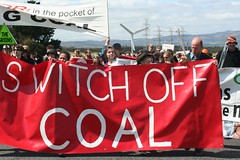 The International Energy Agency (IEA) has just reported another increase in CO2 emissions for 2011 to a new record high of 31.6 gigatonnes (Gt), an increase of 1.0 Gt on 2010, or 3.2%. Last year the IEA reported a record high of 30.6 Gigatonnes during 2010, with Greenhouse gases increasing 6 per cent, one of the largest annual increases on record.
The International Energy Agency (IEA) has just reported another increase in CO2 emissions for 2011 to a new record high of 31.6 gigatonnes (Gt), an increase of 1.0 Gt on 2010, or 3.2%. Last year the IEA reported a record high of 30.6 Gigatonnes during 2010, with Greenhouse gases increasing 6 per cent, one of the largest annual increases on record.
According to the IEA, global energy-related emissions in 2020 must not be greater than 32.6 Gt to be consistent in limiting warming to 2ºC. We are traveling very close to global greenhouse gas pollution limits. "The new data provide further evidence that the door to a 2°C trajectory is about to close," said IEA Chief Economist Fatih Birol. According to the IEA coal accounted for 45% of emissions, oil 35% and natural gas 20%.
During 2011 OECD countries reduced emissions by 0.6%, but was offset by a 6.1% increase in emissions from non-OECD countries.
- China made the largest contribution increasing emissions by 9.3%, but also reducing it's carbon intensity by 15% between 2005 to 2011 through energy efficiency and renewables programs. "What China has done over such a short period of time to improve energy efficiency and deploy clean energy is already paying major dividends to the global environment", said Dr. Birol.
- India's emissions also rose by 8.7% to become the fourth largest emitter after China, the US, and Europe.
- The United States reduced emissions by 1.7%,in 2011 and continues a reduction trend of 7.7% since 2006 arising from lower transport sector use due to economic recession and higher fuel prices, and a shift from coal to natural gas in the power industry.
- Japan's emissions have increased by 2.4% due to increased fossil fuel use following the Fukushima reactor disaster.
- UK greenhouse gas emissions fall 7% in 2011
- Germany dropped overall emissions by some 2 per cent over the previous year. This amounts to a 26.5 per cent decrease compared to the 1990 index year. Transfer of electricity generation from coal and nuclear to greater reliance on renewables such as wind and photovoltaic solar and a mild winter assisted the reduction. Energy from solar recently peeked at a third of all energy generated - 22 gigawatts per hour - during peak times on a Friday and Saturday.
- Australia's greenhouse gas emissions grew by 0.6% in 2011 according to the National Greenhouse Accounts of the Department of Climate Change and Energy Efficiency.
Bernard Keane, writing on Crikey in April 2012, says that Australia is on course to miss the bipartisan target of a 5% reduction in CO2 emissions by 2020. That's even with the Federal Government's carbon price in place.
Sources:
- International Energy Agency Media Release 24 May 2012 - Global carbon-dioxide emissions increase by 1.0 Gt in 2011 to record high
